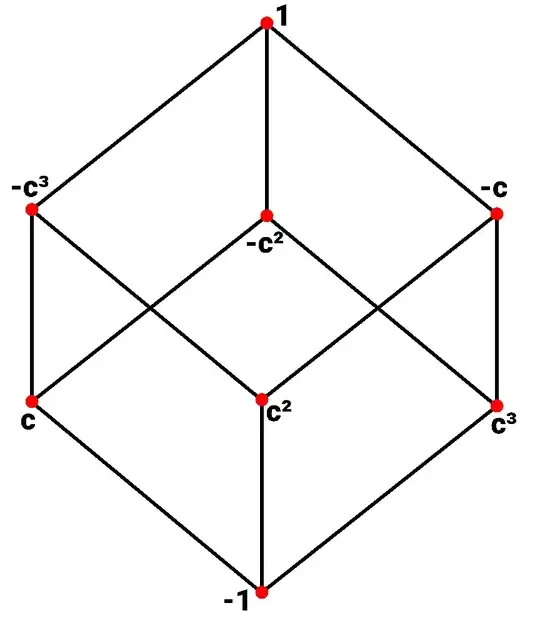In $\Bbb{H}$, the numbers $1$, $i$, $j$, $k$, and their respective negatives can all be seen as the vertices of a cross-polytope or orthoplex. This is true for anything that uses an orthonormal basis, where the number of basis elements coincide with the number of dimensions $n$ in the space, as well as with half the number of vertices of an $n$-orthoplex (the negatives of the basis provide the other half).
I constructed a three-dimensional number system that is instead based on a cube. The motivation is to have a basis polytope that tiles space, which... might not be super useful, but I found the idea interesting. Note that $\Bbb{C}$ and $\Bbb{R}$ have this property, but the property vanishes for orthoplex-based systems in higher dimensions.
So, a cube it is.
Unlike the usual definition of a unit cube, the central cube in this system has vertices on $1$ and $-1$, making it look like this: https://www.geogebra.org/classic/fcm4qcaf
Properties:
This is a vector space with commutative multiplication in three dimensions without any square root of $-1$.
The eight vertices of the cube are all non-primitive 8th roots of unity: $1$, the non-real non-complex $c$, $c^2$, and $c^3$, and their negatives. Four of these are primitive 4th roots of unity: $c$, $c^3$, and their negatives. Just like $-1$, the opposites $c^2$ and $-c^2$ are also primitive square roots of unity.
Again, unlike $\Bbb{H}$, no square root of negative one is defined in this system. If this was in $\Bbb{H}$, the four points $1$, $c$, $c^2$, and $c^3$ would be coplanar, but they are clearly not.
Repeated multiplication leads to the following cycles:
$$c\to{c^2}\to{c^3}\to{1}$$ $$c^2\to{1}$$ $$c^3\to{c^2}\to{c}\to{1}$$ $$-c\to{c^2}\to{-c^3}\to{1}$$ $$-c^2\to{1}$$ $$-c^3\to{c^2}\to{-c}\to{1}$$
The four positive units are equidistant from and equally spaced around the origin, so they as vectors have the following property:
$$1 + c + c^2 + c^3 = 0$$
If you're starting to suspect that this is actually a tetrahedral number system (where the repeated multiplication of $c$ cycles through the four equidistant vertices of a regular tetrahedron), I admit it kind of started that way in my head. But notice that the negatives relate to certain cubic rotational symmetries:
- $-c$ represents the rotation of a cubic face by $90\unicode{xB0}$.
- $-c^3$ represents the previous rotation reversed.
- $-c^2$ represents the rotation of a cubic edge by $180\unicode{xB0}$.
- $-1$ represents the rotation of a space diagonal by $180\unicode{xB0}$.
Speaking of "cubic" units, each cubic unit is a third power of a cubic unit: \begin{array}{r|r} x & x^3 & \\ \hline 1 & 1 & \\ c & c^3 & \\ c^2 & c^2 & \\ c^3 & c & \\ \end{array}
Neat!
Given all this (and the fact that cubes tile space while tetrahedra cannot), I decided that it would be cooler to call this number system cubic instead of tetrahedral.
Relationship with $\Bbb{H}$:
An important note that I need to reiterate is that no square root of $-1$ exists in this three dimensional cubic space. This is why it's okay that the powers of $c$ aren't coplanar with each other. But I also thought of how this number system could interact with quaternion space and its unit sphere of square roots of negative one.
$c^2$ and $-c^2$ are coplanar with the real number line, so $y=2\sqrt{2} + 3c^2$ is also coplanar with them and orthogonal to $1$ (if my calculation was correct). I checked and while its multiplication does seem to produce co-planar results, they seem to diverge and not form a circle (not surprisingly). $z=\frac{c\sqrt{\frac{3}{2}}}{2}-\frac{c^3\sqrt{\frac{3}{2}}}{2}$ is orthogonal to both $1$ and $y$ and similarly divergent.
I think it should be possible to do arbitrary plane rotations by constructing a multiplication table containing both cubic elements and quaternion units, the same way split-complex numbers were combined with complex numbers to produce the split-quaternions. I consider split-complex numbers to be a generalized $n$-cubic number system for $n=2$, so I think this approach could be promising.
Questions:
- Does $\exp(c)$ converge?
- Given the properties of the system, can we embed the central cube inside a dodecahedron such that the 20 vertices are all 20th roots of unity? (All the cubic units are 20th roots of unity, of course, but I'm wondering about the dodecahedral vertices outside the cube.)
- Can $c$ be considered a trivector? Meaning, does the cubic number system fit as a (non-orthogonal) Clifford algebra?
